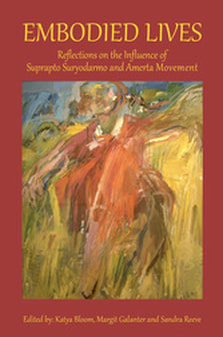|
Amerta Movement - an extract from Embodied Lives
The Practice Amerta Movement may be seen as cultivating an embodied approach to life through the practice of movement as a skilled art. It seems to reach beyond ‘movement meditation’ or ‘dance’ into a movement world that is uniquely sensitizing and integrative. Amerta Movement differs from most other traditional movement arts, like Tai chi or Yoga, or somatic practices, like the Feldenkrais Method or Alexander Technique, because Amerta has no set form, no pre-existing patterns, or series of movements. There is nothing to follow except one’s own experience on all levels, but especially the sensory-motoric – our bodies, on the Earth, and responsive to gravity. Practitioners interact with both environment and self, while also being in communication with the personalities and cultural heritage of fellow movers. A relationship with the past also comes alive as part of the present. Amerta Movement, thus provides a forum for cultural, artistic, atmospheric, and human interaction. This breadth of the practice affects the quality of experience in the movement itself, as well as perceptions of the world in which we live. We receive our connection inward and outward simultaneously. From this we follow the moment-by-moment decisions of our beings in time and space, as we follow our intention to deepen our embodied awareness of the ever-changing here and now. Our bodies listen and speak, choose and allow, as we encounter the border between known and unknown. With an attitude of attentive play, we discover meaning. For most of our lives, after early childhood, our movement settles into and replicates a limited vocabulary of patterns, in which we use our bodies as tools to carry out our wishes and needs. In Amerta Movement, we regain a sense of our bodies as responsive, sensing organisms, and our vocabulary develops from that very different starting place. When we allow our bodies to ‘speak’ or express from that place, with ordinary, daily life movements and their variations – such as lying, rolling, crawling, sitting, walking, jumping – what arises is an enlivening experience, which Prapto calls blossoming. Prapto’s image for the common field of practice, when a group moves together, is that of a garden, where each being is a unique expression of life, and where the micro and the macro levels of one’s experience can connect. The nature of the practice is that we slow things down, relaxing both body and mind. With roots in Vipassana (mindfulness) meditation, daily life movement, non-stylized movement and a Javanese meditation form called Sumarah, the practice helps us to open our senses, to receive what is present and, crucially, to recognize that the present is always changing. The Buddhist principle of non-attachment is central to the Amerta practice, though we are more actively involved in witnessing what comes and goes than we would be in traditional meditation. In this way we discover different points of view, different ways of moving, listening and speaking with our bodies. There are many movement themes which guide practitioners in this process of change in body/time/space, and support our own ability to move with clarity, comfort and a sense of safety. A wide introduction variety of these are brought to life in a range of different contexts by the contributors to this book. Prapto is skilled at creating an atmosphere of openness and dialogue, so that each participant can be seen and can recognize their own unique qualities. We have always been asked to interpret his work through our own experience, and to learn, not only from Prapto, but also from each other. He has insisted that he studies from each of us, as much as we study with him. The stated aim is sharing movement. This approach has given value to each person, as it instils a sense of responsibility. This originates, in part, from giving value to the changing body in a changing environment. The emphasis on change means that even the practice itself isn’t fixed. We are part of a live, embodied, evolving community of practice. |
|

